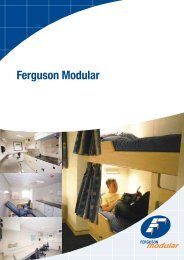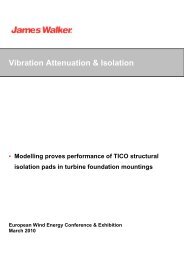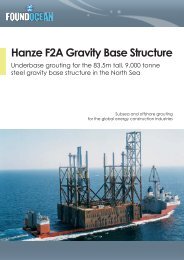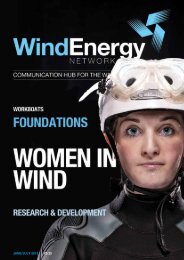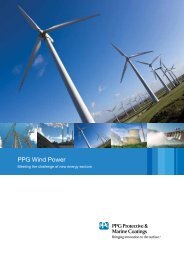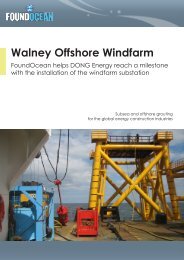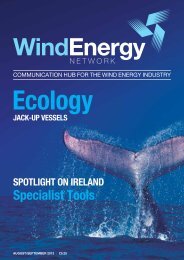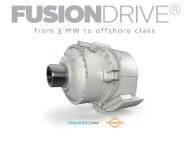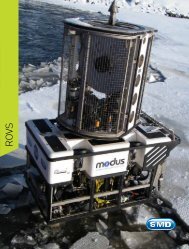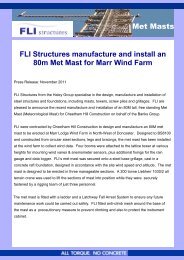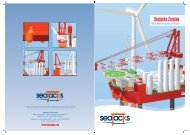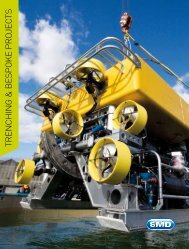RISK MANAGEMENTTo quantify ornot to quantify?that is thequestion...Practical examples of Quantitative Risk AssessmentsIn the last issue Risktec introducedQuantitative Risk Assessments(QRA). Here they continue their seriesof articles on risk management byasking; Is there a role for QRA’s in the<strong>Wind</strong> <strong>Energy</strong> Industry?Back to basics...If we jump back to our second article onRisk Management (June/July 2011), wedefined risk as being the product of thelikelihood of an unwanted event occurring(release of a hazard) and the severity ofthe resulting consequences;The results of a QRA are numericalestimates for risk exposure that cancover the full range of consequenceeffects being considered (e.g. harm tothe environment, plant/asset damage,programme delays, cost overruns, etc.)but are most commonly used in a healthRisk of fatality as aresult of a wind turbineblade failure/throwLikelihood of bladefailure per yearxProbability of a bladelanding at a specificlocationOccupancy rateat specificlocationxProbability of afatality from directimpact of bladeRisk = Likelihood x ConsequenceImage courtesy of Infinergy LtdProbability of loss ofcontainment from bladeimpact [tank integrity] leadingto release of gasxGas concentration at aspecific location[gas dispersion]xProbability of ignitionof releasexOccupancy rateat specificlocationxProbability of afatality from resultingfire/explosionFigure 1: Considerations for QRA of riskfrom Turbine Blade ‘Throw’ on adjacentmajor hazard facilityRisk = Likelihood x ConsequenceWhilst QRAs come in a vast array ofshapes and sizes, performed using aplethora of tools and techniques, in verysimple terms it is a systematic techniquewhereby appropriate numerical values areapplied to ‘likelihood’ and ‘consequence’allowing the associated risk to beexpressed in numerical terms.and safety context to quantify risk topeople and society in general, for exampleby expressing risk as the frequency offatality per annum.68www.windenergynetwork.co.uk
RISK MANAGEMENTSo is there a role for QRA in the<strong>Wind</strong> <strong>Energy</strong> Industry?Let’s consider three specifichazards:1 Turbine blade failure andsubsequent ‘throw’.For the vast majority of wind turbines,sited in remote/rural locations, theconsequences of such an event arerelatively low. Here, simple deterministicprinciples (e.g. compliance with designstandards) will be adequate todemonstrate this risk to be tolerableand properly managed. However, ifwe consider a turbine sited close to alarge gas storage facility, the storyis very different. Whilst a highly unlikelyevent, a ‘thrown’ blade could strike avessel resulting in a loss ofcontainment leading to a gas release.Were this to be ignited it could leadto an explosion resulting in multiplefatalities. Clearly a QRA is appropriatehere which would consider a range offactors as illustrated in Figure 1.However this need is not driven byissues specific to wind energy butrather the nature of the adjacentfacility. It is inconceivable that sucha major hazard facility will not alreadyhave a QRA as part of an overallFacility ‘Safety Case’ and so the bulkof work is already done for you. A fullQRA is therefore unlikely to benecessary. A more simple comparisonof the probability of a blade strikeagainst other existing known hazardswith similar effects may be all that isneeded to assess whether this newrisk is tolerable.2 Personnel transfer on/off anOffshore <strong>Wind</strong> Turbine.This is widely recognised as one ofthe more significant risks of offshorewind operations. Whilst a relativelysimple hazard which could beassessed via deterministic means,a precedent has been set for the useof QRA for personnel transfers in theoffshore oil and gas industry. Withsuch a precedent comes considerablehistorical and predictive data onthe likelihood and consequence of thishazard. As a result, a simple personneltransfer frequency calculation alliedto existing, appropriate data, may beall that is necessary to assess thishazard via quantitative means.3 Offshore <strong>Wind</strong> Farm Ship CollisionStudy.Depending on the location of anoffshore wind turbine, it may benecessary [unless the risk can bediscounted via qualitative means] toperform a detailed ship collision study.Such a QRA will quantify the risk ofa ship colliding with a wind turbine.In so doing it will need to quantify thelikelihood of a ship impacting aturbine considering both passing andvisiting vessels via ‘powered’ and‘drifting’ collisions, whilst takingaccount of protective measures inplace such as sea charts [providedturbines marked], radar visibility andfacilities for monitoring and warningvessels in the vicinity. In terms ofconsequences, the QRA will need toconsider damage to the turbine aswell as the vessel itself. The evaluationof impact damage is likely to becomplex and require considerablestructural engineering and marineexperience to develop a correlationbetween collision speed/energy anddamage. A breached oil tanker is likelyto cause significant environmentalharm. Whilst this hazard clearly doesnot exist within the wind farm, ifinappropriately sited, a wind turbinecould contribute to the release of thishazard, hence the associated riskmust be considered as part of thewind farm safety justification. Suchship collision QRAs are a standardelement of any offshore oil and gasfacility ‘Safety Case’, so existingprecedents exist for risk tolerabilitywhich can be tailored to suit thisspecific application to determinewhether the quantified risk is acceptable.Whilst these are only three very specific,anecdotal examples, they do indicatethat there is a role for QRA in the windenergy industry. However this is certainlynot a black and white issue. Theseexamples clearly highlight that the natureand scope of any QRA will vary hugelybased on a range of factors including;nature of the hazard and its development,available information, existing precedents,stakeholder expectations, but perhapsmore crucially, what role the QRA is toplay within the overall safety justificationstrategy. This must be fully understoodbefore embarking on any QRA.Gareth EllorRisktec Solutions Ltdwww.risktec.co.ukwww.windenergynetwork.co.uk69



